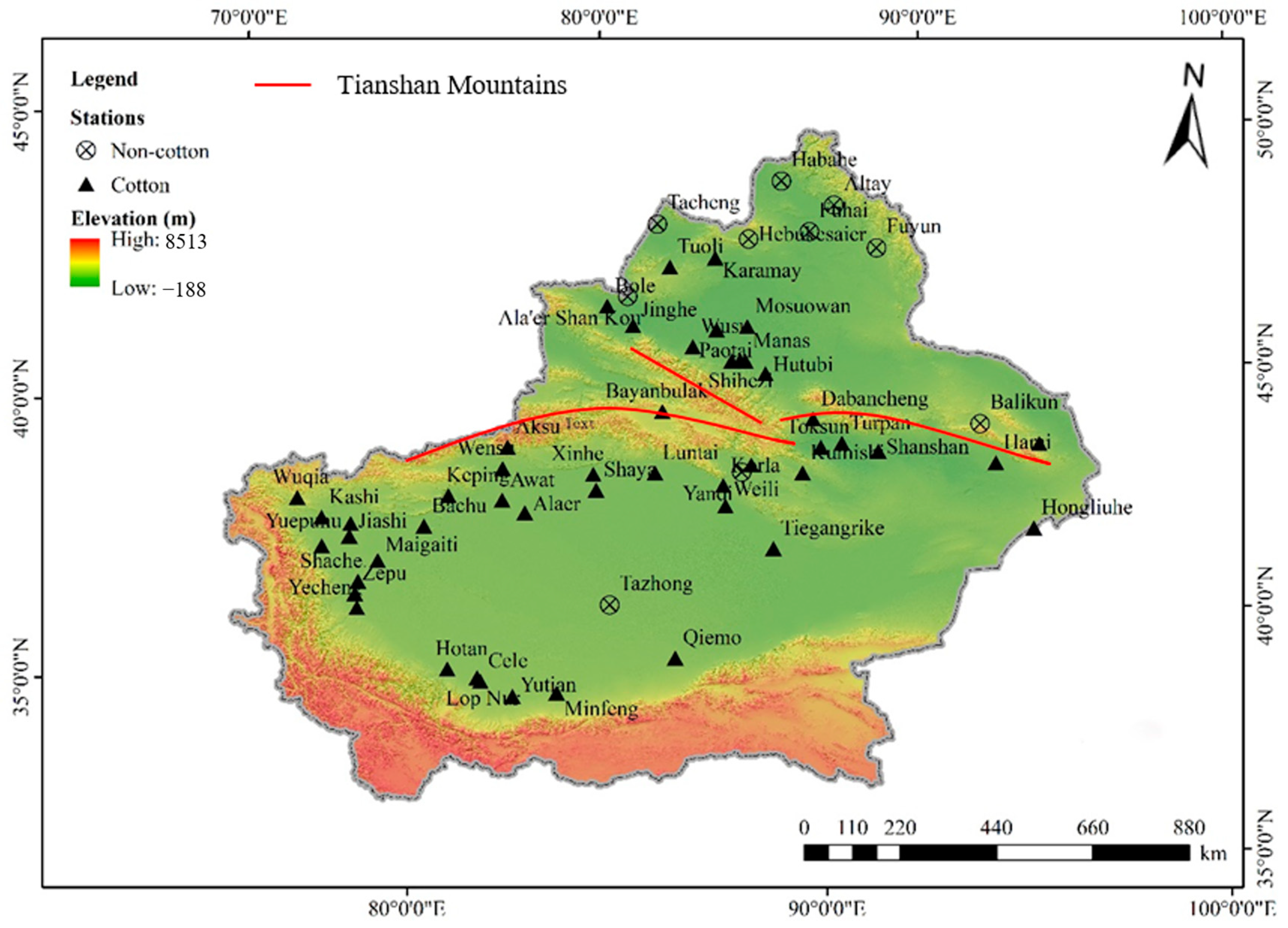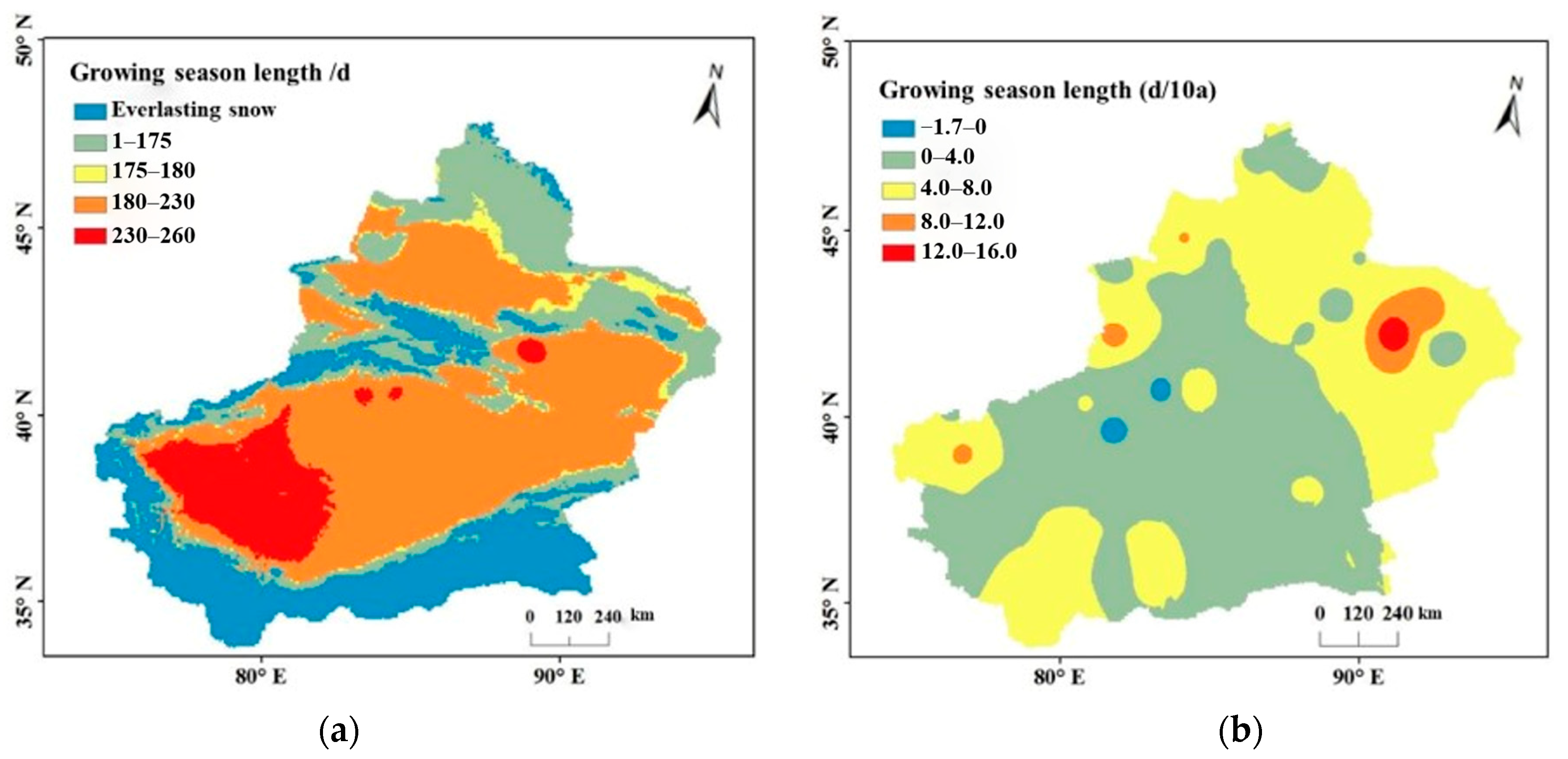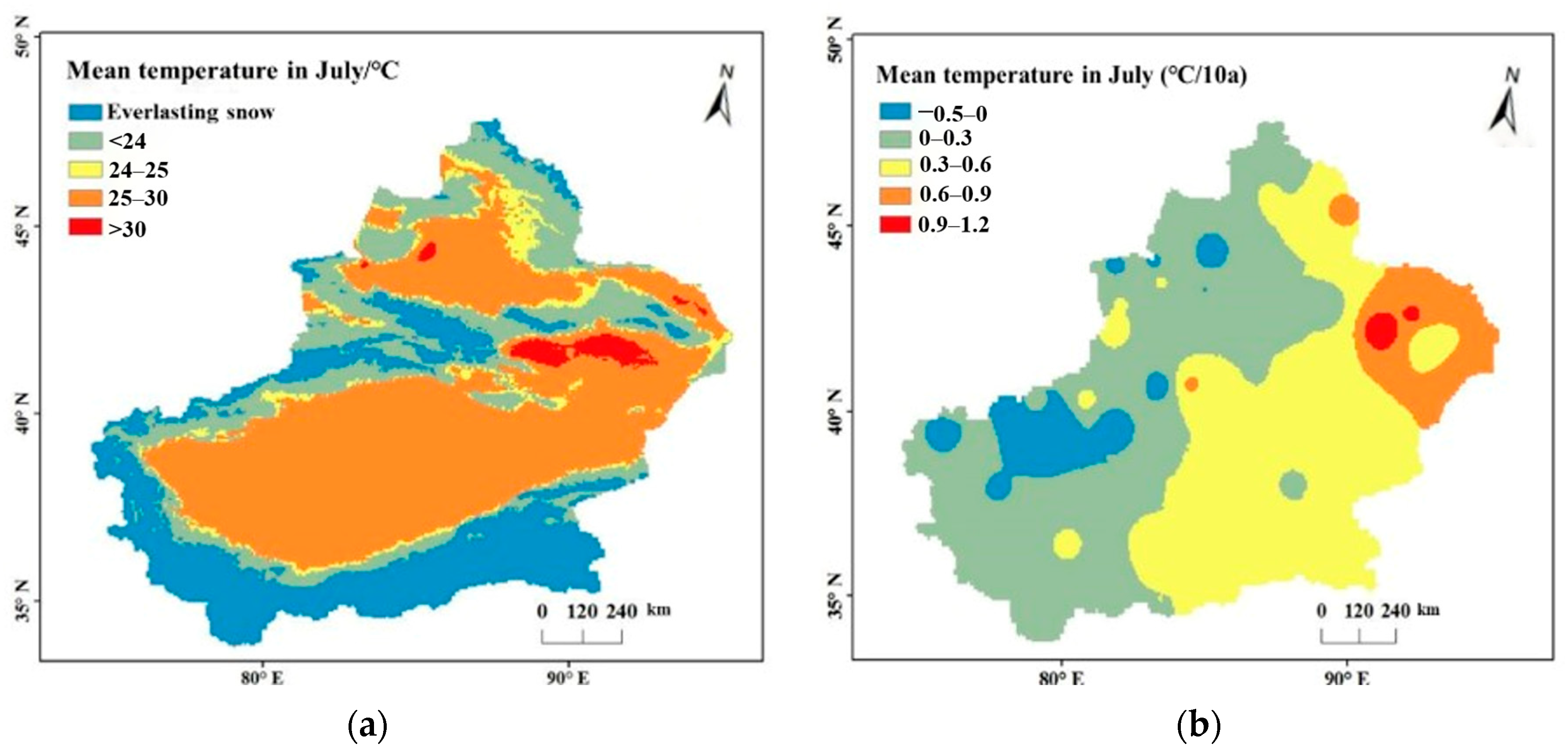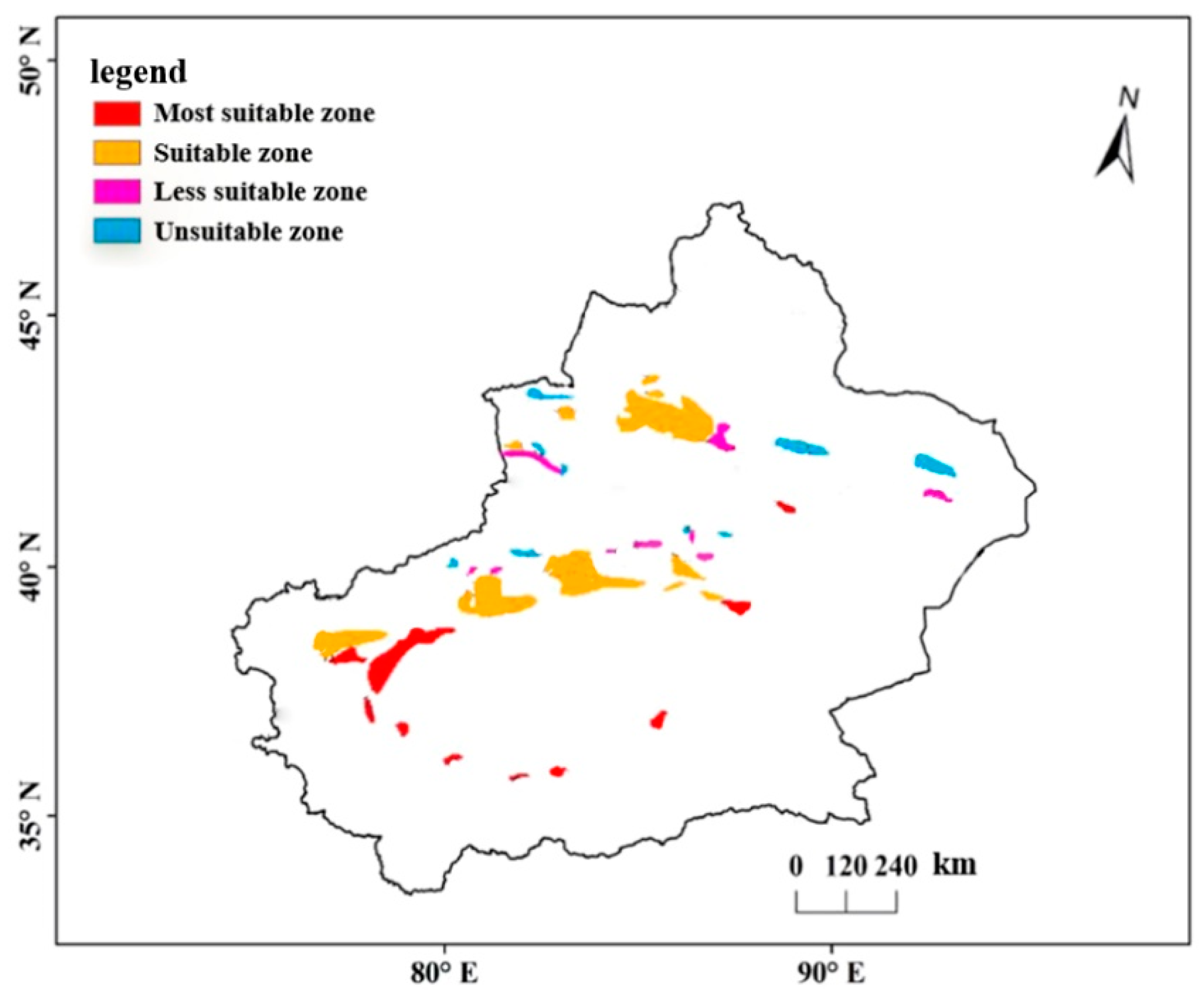Assessing the Impacts of Mulching-Induced Warming Effects on Machine-Picked Cotton Zones
Abstract
:1. Introduction
- (1)
- Insufficient attention given to the climatic resource necessities of machine-harvested cotton: Xinjiang ranks highest in terms of the mechanization level of cotton cultivation (National Bureau of Statistics data in 2023: the mechanized harvesting rate of cotton in Xinjiang has exceeded 81%, accounting for over 80% of national total production). The aforementioned studies mainly divide the suitable areas for cotton cultivation based on factors such as the length of the growing season, the average July temperature, and the sum of active temperatures above a certain threshold; however, the specific climate resource requirements of machine-harvested cotton have not been adequately considered. It is necessary to develop targeted subsidiary indicators in order to divide the suitable regions for machine-harvested cotton cultivation in Xinjiang.
- (2)
- Deficit of quantitative research investigating the effects of mulching-induced warming on the suitability regions for varied-maturity cotton: According to statistics, as of 1994, 96.67% of the total sowing area in Xinjiang adopted mulching cultivation for cotton [27]. Mulching not only increases the soil temperature and moisture retention but also compensates for the temperature conditions required for cotton growth [27,28,29,30]. Both global climate warming and the use of mulching techniques in cotton cultivation can affect the heat conditions required for cotton plants’ growth, which may influence the planting regions for cotton; however, most of the current research focuses on the suitability zoning of Xinjiang cotton under the background of global warming [23,24,31].
2. Data Sources and Processing Methods
2.1. Overview of the Study Area and Data Sources
2.2. Research Methods
2.2.1. Calculation Methods for Meteorological Indices
- −
- “a” and “b” represent the start and end dates, respectively, for calculating the accumulated temperatures. When calculating the accumulated temperature during April–May, “a” is 1 April, and “b” is 31 May. When calculating the accumulated temperatures during the growth period, “a” and “b” denote the start and end dates, respectively, of the daily average temperature ≥ 10 °C within the cotton plants’ growing season, which are determined using a 5-day sliding average method.
- −
- “Ti” represents the daily average temperature, °C.
2.2.2. Probability of Exceedance
2.2.3. Calculation of the Heat Compensation Value under Plastic Film Mulching
- (1)
- Based on the accumulated temperature values required for the seedling stage and the budding stage ≥10 °C the number of days from seedling emergence (NL1) and budding (NL2) in Xinjiang each year was estimated.
- (2)
- The number of days (Nm1 and Nm2) for mulched cotton during the seedling and budding stages was estimated based on the daily average temperature and the corresponding number of days for the open-field cotton using a trial calculation method. The calculation formula is as follows:
- (3)
- The equation for estimating the heat compensation value of the effective temperatures during the seedling and budding stages of plastic-film-mulched cotton (ΔATM1 and ΔATM2) based on the number of days (Nm1 and Nm2) is as follows:
- (4)
- The equation for estimating the total heat compensation value of the effective temperatures during the seedling and budding stages (ΣATM) is as follows:
2.2.4. Zoning Indicators
2.3. Data Processing
2.3.1. Interpolation Methods
2.3.2. Trend Detection
2.3.3. Objective Weight Determination
2.3.4. Climate Suitability Zoning
3. Results and Analysis
3.1. Zoning Indicator Interpolation and Weighting
3.1.1. Zoning Indicators’ Interpolation
3.1.2. Zoning Indicators’ Weights
3.2. Spatial and Temporal Distribution of Heat Indicators
3.2.1. Length of Growing Season
3.2.2. Sum of Active Temperatures ≥ 10 °C
3.2.3. Average Temperature in July
3.2.4. Last Frost Date
3.2.5. Sum of Active Temperatures ≥ 10 °C in April–May
3.2.6. Defoliant Spray Time
3.3. Mechanized Cotton Planting Suitability Zoning in Xinjiang
3.3.1. Results of Mechanized Cotton Planting Suitability Zoning in Xinjiang
3.3.2. Changes in the Zoning of Machine-Picked Cotton under a Mulching-Induced Warming Mechanism
4. Discussion
5. Conclusions
- (1)
- The heat resources in Xinjiang exhibited a spatial distribution pattern of “more in the southern part than the northern part, and more in the plains and basins than in the mountains”. The latest date of defoliant application and the occurrence of the frost-free period showed a spatial distribution pattern of “earlier in Northern Xinjiang than Southern Xinjiang, and earlier in mountain areas than plains and basins”. Under global climate warming, the frost-free period in most parts of Xinjiang advanced, the latest date of defoliant application was postponed, and the growing season lengthened from 1981 to 2020. In addition, the cumulative ≥ 10 °C temperature in April–May, the sum of active temperatures ≥ 10 °C during the entire growth period, and the average temperature in July significantly increased.
- (2)
- Compared with 1981–1989, there were varying trends in the planting areas of different suitable regions during the years 1990–2020. In the context of climate warming, stimulated by market demand and policy guidance, the planting area of machine-picked cotton in the most suitable region in Xinjiang increased by 160.43%, the area in the suitable region increased by 25.21%, and the areas in the less suitable and unsuitable regions decreased to different degrees. As a result, the total planting area increased by 169.49%; however, there are hidden risks of unreasonable regional planning and blind expansion.
- (3)
- Mulching technology has a limited but positive effect on the expansion of suitable areas for machine-picked cotton in Xinjiang. During the years 1991–2020, the warming effect of plastic film had little impact on the cultivable area in the most suitable cotton region, while the cultivable area in the suitable region expanded by 15.7% compared to the planting area, suggesting that the warming climate and the extensive application of mulching technology still provide untapped potential for the suitable cotton region of Xinjiang, and it is recommended to expand the cotton planting area in the suitable zone. On the other hand, the cultivable areas in the less suitable and unsuitable regions decreased by 14.5% and 7.8%, respectively, suggesting that the planting areas of machine-picked cotton in both less suitable and unsuitable zones, particularly with the existing regional planning, continue to demonstrate an irrational expansion.
- (4)
- Finally, these findings reveal the heat demand of machine-picked cotton and the distribution of heat resources in Xinjiang, aiding in more effective resource allocation and cultivation strategy development in similar regions. Insights into the impact of climate warming on planting areas and the positive effects of mulching technology underscore opportunities and challenges for cotton production in Xinjiang and other regions experiencing similar climatic shifts. The increase in planting areas in suitable regions emphasizes the importance of integrating agricultural policies with climate adaptation strategies. Principles regarding heat resource management and cultivation practices in Xinjiang can serve as a foundation for enhancing agricultural resilience and productivity in analogous regions worldwide. To maintain the resilience and productivity of the cotton industry in Xinjiang, proactive land management strategies are of utmost importance to optimize cotton production in response to changing climate patterns. Therefore, policymakers need to prioritize sustainable land allocation practices, ensuring reasonable land distribution appropriate to the prevailing climatic conditions in order to support the sustainable growth of the cotton industry.
Author Contributions
Funding
Institutional Review Board Statement
Informed Consent Statement
Data Availability Statement
Conflicts of Interest
References
- IPCC. Summary for Policymakers. In Climate Change 2021: The Physical Science Basis; Contribution of Working Group I to the Sixth Assessment Report of the Intergovernmental Panel on Climate Change, Masson-Delmotte, V., Zhai, P., Pirani, A., Connors, S.L., Péan, C., Berger, S., Caud, N., Chen, Y., Goldfarb, L., Gomis, M.I., Eds.; Cambridge University Press: Cambridge, UK, 2021; in press. [Google Scholar]
- Terando, A.; Easterling, W.E.; Keller, K.; Easterling, D.R. Observed and Modeled Twentieth-Century Spatial and Temporal Patterns of Selected Agro-Climate Indices in North America. J. Clim. 2012, 25, 473–490. Available online: https://journals.ametsoc.org/view/journals/clim/25/2/2011jcli4168.1.xml (accessed on 10 May 2023). [CrossRef]
- Kukal, M.S.; Irmak, S.U.S. Agro-Climate in 20th Century: Growing Degree Days, First and Last Frost, Growing Season Length, and Impacts on Crop Yields. Sci. Rep. 2018, 8, 6977. [Google Scholar] [CrossRef] [PubMed]
- Quaye, F.; Nadolnyak, D.; Hartarska, V. Climate change impacts on farmland values in the Southeast United States. Sustainability 2018, 10, 3426. [Google Scholar] [CrossRef]
- Jiang, T.C.; Wang, B.; Xu, X.J.; Cao, Y.X.; Liu, D.L.; He, L.; Jing, N.; Ma, H.J.; Chen, S.; Zhao, K.F.; et al. Identifying sources of uncertainty in wheat production projections with consideration of crop climatic suitability under future climate. Agric. For. Meteorol. 2022, 319, 108933. [Google Scholar] [CrossRef]
- Liu, G.; Mai, J. Habitat shifts of Jatropha curcas L. in the Asia-Pacific region under climate change scenarios. Energy 2022, 251, 123885. [Google Scholar] [CrossRef]
- Skaggs, K.E.; Irmak, S. Long-term trends in air temperature distribution and extremes, growing degree days, and spring and fall frosts for climate impact assessments on agricultural practices in Nebraska. J. Appl. Meteorol. Climatol. 2012, 51, 2060–2073. [Google Scholar] [CrossRef]
- Li, S.; Shi, X.; Lu, J.; Chen, F.; Chu, Q. Climate warming and crop management: A comprehensive analysis of changes on distribution of suitable areas for double rice. Agronomy 2022, 12, 993. [Google Scholar] [CrossRef]
- Edmar, I.E.; Fischer, G.; Velthuizen, H.V.; Walter, C.; Ewert, F. Global hot-spots of heat stress on agricultural crops due to climate change. Agric. For. Meteorol. 2013, 170, 206–215. [Google Scholar] [CrossRef]
- Zhao, C.; Liu, B.; Piao, S.; Wang, X.; Lobell, D.B.; Huang, Y.; Asseng, S. Temperature increase reduces global yields of major crops in four independent estimates. Proc. Natl. Acad. Sci. USA 2017, 114, 9326–9331. [Google Scholar] [CrossRef]
- Li, S.; Lu, Z.; Zhao, J.; Luo, M.; Chen, F.; Chu, Q. Changes in planting methods will change the potential distribution of rice in South China under climate warming. Agric. For. Meteorol. 2023, 331, 109355. [Google Scholar] [CrossRef]
- Hatfield, J.L.; Prueger, J.H. Temperature extremes: Effect on plant growth and development. Weather Clim. Extrem. 2015, 10, 4–10. [Google Scholar] [CrossRef]
- Shkolnik, I.M.; Pigol’tsina, G.B.; Efimov, S.V. Agriculture in the arid regions of Eurasia and global warming: RCM ensemble projections for the middle of the 21st century. Russ. Meteorol. Hydrol. 2019, 44, 540–547. [Google Scholar] [CrossRef]
- Deng, Z.Y.; Zhang, Q.; Pu, J.Y. The impact of climate warming on crop planting and production in northwestern China. Acta Ecol. Sin. 2008, 28, 3760–3768. Available online: https://kns.cnki.net/kcms/detail/detail.aspx?FileName=STXB200808033&DbName=CJFQ2008 (accessed on 10 May 2023).
- Mai, J.F.; Liu, G.L. Modeling and predicting the effects of climate change on cotton-suitable habitats in the Central Asian arid zone. Industial Crops Prod. 2023, 191, 115838. [Google Scholar] [CrossRef]
- Chen, P.X.; Mao, W.Y. GIS-based spatial interpolation of air temperature in Xinjiang. Arid Land Geogr. 2012, 35, 438–445. [Google Scholar] [CrossRef]
- Li, J.L.; Zhang, S.Q.; Pu, Z.C.; Wang, M.Q.; Wang, S.L.; Zhao, S.Q. Refined spatio-temporal variation analysis of temperature in Xinjiang in recent 50 years. J. Beijing Norm. Univ. (Nat. Sci.) 2013, 36, 229–237. [Google Scholar] [CrossRef]
- Pu, Z.C.; Zhang, S.Q.; Li, J.L.; Wang, M.Q. Spatiotemporal change of duration and sum of active temperaturess of temperature≥ 0 °C in Xinjiang in recent 50 years. Arid Zone Res. 2013, 30, 781–788. [Google Scholar] [CrossRef]
- Zhang, S.Q. The impact of global warming on frost-free periods from 1961 to 2010 in Xinjiang. Resour. Sci. 2013, 35, 1908–1916. Available online: https://api.semanticscholar.org/CorpusID:202171632 (accessed on 11 May 2023).
- Xinjiang Agricultural Association. Cotton-planting areas division and corresponding countermeasures in north Xinjiang. Xinjiang Agric. Sci. 1995, 32, 5–8. Available online: https://kns.cnki.net/kcms/detail/detail.aspx?FileName=XJNX501.001&DbName=CJFQ1995 (accessed on 10 May 2023).
- Yao, Y.S. New discussion on cotton-planting areas division in Xinjiang. China Cotton 2001, 28, 2–5. Available online: https://kns.cnki.net/kcms/detail/detail.aspx?FileName=ZMZZ200102000&DbName=CJFQ2001 (accessed on 10 May 2023).
- Huang, Z.K.; Cui, D.C. Ecological regionalization of cotton production in China. Cotton Sci. 2002, 14, 185–190. Available online: https://kns.cnki.net/kcms/detail/detail.aspx?FileName=MHXB200203013&DbName=CJFQ2002 (accessed on 10 May 2023).
- Li, L.; Wu, H.; Gao, Y.; Zhang, S. Predicting Ecologically Suitable Areas of Cotton Cultivation Using the MaxEnt Model in Xinjiang, China. Ecologies 2023, 4, 654–670. [Google Scholar] [CrossRef]
- Pu, Z.C.; Zhang, S.Q.; Bin, J.; Dou, X.Y. The influence of climate warming on the zoning of cotton cultivation in Wuchang area of Xinjiang. Adv. Clim. Chang. Res. 2012, 8, 257–264. [Google Scholar] [CrossRef]
- Zhang, S.Q.; Pu, Z.C.; Li, J.L.; Li, X.J.; Ji, R.C.; Wang, M.Q.; Li, Y. Changes in zoning of cotton cultivation in southern Xinjiang under the background of climate warming. Chin. J. Agrometeorol. 2015, 36, 594–601. Available online: https://kns.cnki.net/kcms/detail/detail.aspx?FileName=ZGNY201505009&DbName=CJFQ2015 (accessed on 10 May 2023).
- Mauget, S.A.; Adhikari, P.; Leiker, G.; Baumhardt, R.L.; Thorp, K.R.; Ale, S. Modeling the effects of management and elevation on West Texas dryland cotton production. Agric. For. Meteorol. 2017, 247, 385–398. [Google Scholar] [CrossRef]
- Dai, L. The initiation and promotion of cotton planting and plastic film mulching in northern Xinjiang. Xinjiang Local Chrononicles 1995, 42–43. Available online: https://kns.cnki.net/kcms/detail/detail.aspx?FileName=XJDF199504019&DbName=CJFQ1995 (accessed on 10 May 2023).
- Gao, H.; Yan, C.; Liu, Q.; Ding, W.; Chen, B.; Li, Z. Effects of plastic mulching and plastic residue on agricultural production: A meta-analysis. Sci. Total Environ. 2019, 651, 484–492. [Google Scholar] [CrossRef] [PubMed]
- Zhumilaiti, T.; Lin, T.; Yan, C.R.; Dilimaimaiti, D.; Deng, F.N.; Wu, F.Q.; Kong, S.; Tang, Q.X. Effects of plastic film mulching duration on water and heat, cotton water consumption, and yield of cotton fields in Xinjiang. Trans. Chin. Soc. Agric. Eng. 2018, 34, 113–120. [Google Scholar] [CrossRef]
- Xiao, M.; Zhong, J.; Zhao, L. Studies on the correlation between cotton soil temperature and air temperature, and the compensating action of soil temperature increase in the mulched cotton field on effective air accumulation temperature. J. Xinjiang Agric. Univ. 1998, 1, 5–9. Available online: https://kns.cnki.net/kcms/detail/detail.aspx?FileName=XJNY804.001&DbName=CJFQ1998 (accessed on 10 May 2023).
- Li, Y.C.; Xie, G.H.; Li, X.J.; Yao, Y.L. Cotton zoning in Aksu area of Xinjiang based on GIS. China J. Agrometeorol 2007, 28, 450–452. Available online: https://kns.cnki.net/kcms/detail/detail.aspx?FileName=ZGNY200704027&DbName=CJFQ2007 (accessed on 10 May 2023).
- Hu, L.T.; Hu, Q.; Pan, X.B.; Ma, X.Q.; Xu, L.; Wang, X.R.; Zhang, H. Effects of global warming and plastic mulching on cotton-planting zoning with different matures in Xinjiang. Trans. Chin. Soc. Agric. Eng. (Trans. CSAE) 2019, 35, 90–99. [Google Scholar] [CrossRef]
- Liu, S.J.; Zhou, G.S.; Fang, S.B. Apreliminary study of the northern planting boundary of rubber tree cultivation in China. Acta Ecol. Sin. 2016, 36, 1272–1280. [Google Scholar] [CrossRef]
- Chu, Z.; Guo, J.P.; Zhao, J.F. Impacts of projected climate change on agricultural climate resources in Northeast China. Acta Geogr. Sin. 2017, 72, 1248–1260. [Google Scholar] [CrossRef]
- He, L.; Mao, L.X. Change of soybean climatic suitability in Northeast China under climate change. Chin. J. Eco-Agric. 2023, 31, 690–698. [Google Scholar] [CrossRef]
- Xiao, M.; Zhong, J.P.; Li, B.C.; Zhao, L. The effect and pattern of soil temperature increase in cotton field mulched with plastic film and the modification on the GOSSYM simulation model. J. Xinjiang Agric. Univ. 1997, 20, 32–39. Available online: https://kns.cnki.net/kcms/detail/detail.aspx?FileName=XJNY704.008&DbName=CJFQ1997 (accessed on 10 May 2023).
- DB 65/T 2266-2019; The Cultivation Technique Rules for Mechanically Harvested of Upland Cotton Cultivars. Available online: https://www.waitang.com/report/201600.html (accessed on 10 May 2023).
- Salmi, T.; Määttä, A.; Ruoho-Airola, P.; Tuija, T.; Amnell, T. Detecting Trends of Annual Values of Atmospheric Pollutants by the Mann-Kendall Test and Sen’s Solpe Estimates the Excel Template Application MAKESENS. Publications on Air Quality. 2002, p. 31. Available online: https://www.researchgate.net/publication/259356944 (accessed on 10 May 2023).
- De Martino, A.; De Martino, D. An introduction to the maximum entropy approach and its application to inference problems in biology. Heliyon 2018, 4, e00596. [Google Scholar] [CrossRef]
- Qiao, D.; Bao, L.L.; Lin, T.; Lin, T.; Tang, Q.X. Analysis of the Application and Contribution of Mulching Technology in Typical Mulching Areas of Xinjiang. J. Anhui Agric. Sci. 2023, 51, 226–230. [Google Scholar] [CrossRef]
- China’s Historical Review: 60 Years of Development and Retrospect on Xinjiang Cotton Industry. Available online: https://www.sohu.com/a/457450257_501405 (accessed on 26 March 2021).
- Xinjiang Statistical Yearbook. 2022. Available online: https://tjj.xinjiang.gov.cn/tjj/tjnj/jump.shtml (accessed on 1 May 2023).
- Shi, X.; Wang, C.; Zhao, J.; Wang, K.; Chen, F.; Chu, Q. Increasing inconsistency between climate suitability and production of cotton (Gossypium hirsutum L.) in China. Ind. Crops Prod. 2021, 171, 113959. [Google Scholar] [CrossRef]
- Zhao, L.; Zhong, J.P.; Zhao, F.Q.; Bi, S.J.; Duan, R.P.; Liu, Z.Y. GOSSYM and applications under the condition of north Xinjiang cotton region. J. Xinjiang Agric. Univ. 1999, 22, 43–50. Available online: https://kns.cnki.net/kcms/detail/detail.aspx?FileName=XJNY901.008&DbName=CJFQ1999 (accessed on 10 May 2023).
- Li, J.L.; Pu, Z.C.; Zhang, S.Q.; Wang, M.Q.; Li, X.J.; Xu, W.X. Impact of climate change on cotton-planting zoning in North Xinjiang during 1961–2012. Cotton Sci. 2015, 27, 22–30, (In Chinese with English abstract). [Google Scholar]
- Ndamani, F.; Watanabe, T. Developing indicators for adaptation decision-making under climate change in agriculture: A proposed evaluation model. Ecol. Indic. 2017, 76, 366–375. [Google Scholar] [CrossRef]
- Li, N.; Yao, N.; Li, Y.; Chen, J.Q.; Liu, D.L.; Biswas, A.; Li, L.C.; Wang, T.X.; Chen, X.G. A meta-analysis of the possible impact of climate change on global cotton yield based on crop simulation approaches. Agric. Syst. 2021, 193, 103221. [Google Scholar] [CrossRef]









| Regionalization | Crop Variety | Climatological Growing Season Length (d) | Mean Temperature in July (°C) | Sum of Active Temperatures ≥ 10 °C |
|---|---|---|---|---|
| Most suitable zone | Medium maturing | ≥200 | ≥30 | ≥4500 |
| Suitable zone | Medium–early maturing | 180–200 | 26–30 | 3800–4500 |
| Less suitable zone | Early maturing | 175–180 | 24–26 | 3600–3800 |
| Unsuitable zone | Extra-early maturing | 165–175 | 23–24 | 3200–3600 |
| Regionalization | Last Frost Day (d) | April–May Sum Active Temperatures (°C) | Defoliant Spray Time (d) |
|---|---|---|---|
| Most suitable zone | Before 1 April | >500 | After 18 September |
| Suitable zone | 1–10 April | 400–500 | 10–18 September |
| Less suitable zone | 11–20 April | 350–400 | 27 August–9 September |
| Unsuitable zone | After 20 April | <350 | Before 27 August |
| Zoning Indicators | Geographical Relationship Model | Correlation Coefficient | F-Value |
|---|---|---|---|
| Sum of active temperatures ≥ 10 °C | −0.041φh − 2.779φ2 + 10,606.182 | 0.935 | 347.56 |
| Climatological growing season length | −0.02φh − 0.074φλ + 531.291 | 0.802 | 97.46 |
| Mean temperatures in July | −1.666 × 10−4φh − 7.676 × 10−3φ2 + 46.07 | 0.905 | 227.335 |
| Defoliant spray time | −0.001φh − 0.039φ2 + 348.796 | 0.853 | 133.605 |
| April–May sum active temperatures | −0.007φh − 0.565φ2 + 1731.55 | 0.895 | 204.101 |
| Last frost day | 0.049φλ + 0.001φh − 105.228 | 0.830 | 117.011 |
| Regional Indicator | Sum of Active Temperatures ≥ 10 °C | Climatological Growing Season Length | Mean Temperature in July | Defoliant Spray Time | April–May Sum of Active Temperatures | Last Frost Day |
|---|---|---|---|---|---|---|
| Weight | 0.33 | 0.26 | 0.16 | 0.07 | 0.08 | 0.1 |
| Regionalization | Area (×103 km2) | Proportions of the Total Area (%) |
|---|---|---|
| Most suitable zone | 3.92 | 18.0 |
| Suitable zone | 13.66 | 63.6 |
| Less suitable zone | 2.00 | 8.3 |
| Unsuitable zone | 2.17 | 10.1 |
| Regionalization | Area/(×103 km2) | Percentage of Increasing Area (%) | ||
|---|---|---|---|---|
| 1981–1989 | 1990–2020 | Increasing Area | ||
| Most suitable zone | 1.39 | 3.92 | 2.23 | 160.4 |
| Suitable zone | 10.91 | 13.66 | 2.75 | 25.2 |
| Less suitable zone | 2.00 | 1.79 | −0.21 | −10.5 |
| Unsuitable zone | 2.30 | 2.17 | −0.13 | −5.7 |
| Regionalization | Area/(×103 km2) | Percentage of Increasing Area (%) | ||
|---|---|---|---|---|
| 1990–2020 | Plastic Mulching on Increasing Temperature | Increasing Area | ||
| Most suitable zone | 3.92 | 3.92 | 0 | 0.0 |
| Suitable zone | 13.66 | 15.81 | 2.15 | 15.7 |
| Less suitable zone | 1.79 | 1.53 | −0.26 | −14.5 |
| Unsuitable zone | 2.17 | 2.00 | −0.17 | −7.8 |
Disclaimer/Publisher’s Note: The statements, opinions and data contained in all publications are solely those of the individual author(s) and contributor(s) and not of MDPI and/or the editor(s). MDPI and/or the editor(s) disclaim responsibility for any injury to people or property resulting from any ideas, methods, instructions or products referred to in the content. |
© 2024 by the authors. Licensee MDPI, Basel, Switzerland. This article is an open access article distributed under the terms and conditions of the Creative Commons Attribution (CC BY) license (https://creativecommons.org/licenses/by/4.0/).
Share and Cite
Dai, Y.; Zhang, H.; Li, G.; Yang, M.; Lv, X. Assessing the Impacts of Mulching-Induced Warming Effects on Machine-Picked Cotton Zones. Atmosphere 2024, 15, 619. https://doi.org/10.3390/atmos15060619
Dai Y, Zhang H, Li G, Yang M, Lv X. Assessing the Impacts of Mulching-Induced Warming Effects on Machine-Picked Cotton Zones. Atmosphere. 2024; 15(6):619. https://doi.org/10.3390/atmos15060619
Chicago/Turabian StyleDai, Yuanshuai, Hui Zhang, Gang Li, Mingfeng Yang, and Xin Lv. 2024. "Assessing the Impacts of Mulching-Induced Warming Effects on Machine-Picked Cotton Zones" Atmosphere 15, no. 6: 619. https://doi.org/10.3390/atmos15060619





